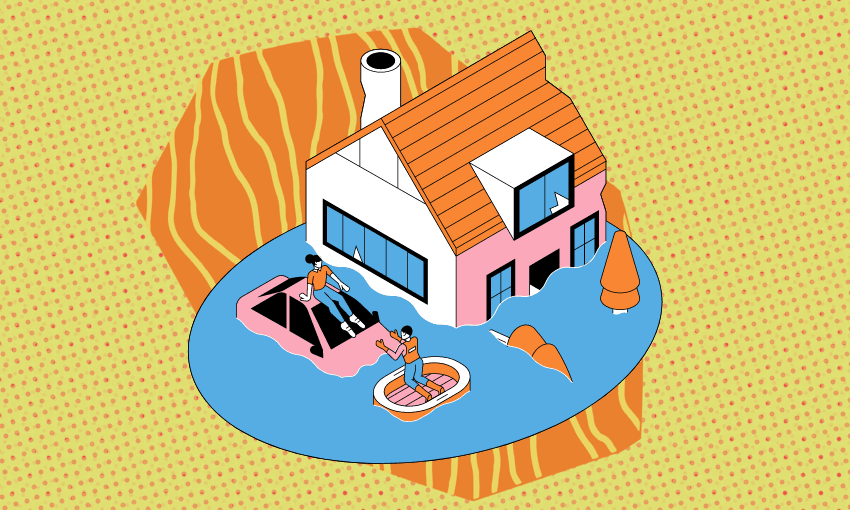Kiwibank chief economist Jarrod Kerr explains what effect climate change will have on inflation, housing and policy – and whether there’s a way out.
Climate change. It’s a gigantic force and it’s coming into play at a time when New Zealand is already struggling with inflation. We’ve gone from a peak of 7.3% to 4.7%, but that’s not enough for the Reserve Bank of New Zealand to commence cutting the Official Cash Rate (OCR). More progress is needed. It’s not until the September quarter we expect Kiwi inflation to go below 3%, but it’s not until mid-October that we see that in writing. So that leaves the November meeting as the earliest date to begin delivering rate cuts.
The cost of transitioning and substituting to renewable sources is inflationary. The cost of assessing climate related risks, like flooding, is inflationary. We are seeing, and will continue to see, rising insurance premiums, and council rates. And then there’s the infrastructure costs associated with climate change, like cyclones. Rebuilding outdated and inadequate infrastructure is inflationary. Building back better, by looking to future proof infrastructure for an ever-increasing population, is very inflationary. We’re paying (through the nose) for decades of underinvestment.
Climate change will heat already heated inflation
More frequent severe weather events will cause more damage, which will become increasingly expensive to rebuild from and insure against, forcing price hikes in affected industries. The floods and cyclone that ripped through the North Island last year are an unfortunate example. The rebuild cost is estimated at over $13 billion and growing, lost crops hurt exports by around $1 billion and caused a spike in some food prices (like apples), but there are structural changes. Insurance costs and council rates are being marked higher in response.
Kiwi are paying for decades of underinvestment in key infrastructure. Councils are loaded up to the eyeballs in debt, and the cost of the infrastructure deficit is ballooning. The more we spend, the more resources we use (from the cost of labour to steel), the more it will cost, and so on. Tackling the required infrastructure spend – which Infrastructure NZ guesstimated to be around $200 billion, with $100bn in the pipeline – will be inflationary in itself.
What’s just as concerning is the revaluation of insurance. All Kiwi face a sharp increase in insurance premiums due to more frequent, and potentially more devastating, climate events. But some will find insurance inhibitive. Properties at risk of rising sea levels, for example, will become uninsurable. Insurers may offer insurance with exclusions, such as flood, meaning they’ll get insurance on everything except what they need. Not helpful. Or insurers will simply refuse to insure some areas.
Without insurance, a mortgage may be unattainable. Without the ability to mortgage a property, a devaluation would be inevitable. IAG, the largest insurer, has flagged 20,000 homes at severe risk of flooding. The managed retreat will be both expensive and reduce the stock of housing in a market with a chronic shortage already.
What does this mean for monetary policy?
Monetary policy cannot address supply-side problems, and the structural lift in inflation makes targeting an inflation rate of 2% in years to come that much harder. The current war on inflation aside, central banks will have to get a little more creative. Looking through large increases in food prices, insurance premiums, council rates and other costs like (re)building supplies, will prove difficult. We’re (inevitably) going to ask the question, is 2% the right target?
The short answer: no. Targeting 2% in a world of rapidly rising climate related costs would require a crushing of non-related costs to compensate. Punishing Peter to pay Paul is problematic and painful. We suspect the conversation will shift towards higher, looser targets, and targets that try to exclude the costs of climate change. A consumer price index (CPI) climate core index may develop, by looking at the basket of goods and services, less insurance premiums for example (similar to the CPI ex-food and energy group).
But it won’t happen just yet, because central banks place an appropriately large weight on their credibility. And they’re currently fighting for their credibility in a post-Covid world where central banks reflated their economies and markets a little too much. Central banks need to break the inflation beast that reared its ugly head following over-stimulation from Covid. Once the beast is broken over during 2024 and 2025 then we’re going to hear more about climate related inflation heading into 2026. “Higher for longer” interest rates will make way for “higher for longer” inflation targets.
What we worry about is a worsening housing shortage
If IAG are correct, and there’s 20,000 homes at risk of severe flooding, we need to relocate. And that’s adding to an already short supply of housing. The monumental task we face in building enough homes for our burgeoning population will get much worse. Our housing is unaffordable. The only way to make it affordable is to build enough houses at a lower price point – something we have been unable to do. We have the solutions, of which prefabricated houses are a big part, but we haven’t invested in the infrastructure to unlock land supply.
We have the technology and ability to adapt. But do we have the (political) will to deliver?
It is not the end of the world as we know it, but it should be. We need to get off fossil fuels. We need to reduce, and ultimately eliminate, our carbon emissions. We need to drastically change the way we do things. We need to embrace technology, especially within the transport space. “Transport is one of our largest sources of greenhouse gas emissions and is responsible for 17 percent of Aotearoa New Zealand’s gross emissions” (Ministry for the Environment). AI has the ability to solve many, if not all, of our problems. Driverless cars are one example of such change. Imagine a world where we don’t own cars, utes or trucks – that’s one major expense we don’t need. It’s a world where we hit an app like Uber, anytime we need to get somewhere or move stuff. And a comprehensive network of driverless, electric or hydrogen, cars fulfil our needs. Putting two to four people in a car, rather than one, would eliminate all our traffic congestion. And the roads we have would be enough, reducing our infrastructure needs. So many problems solved with technology we already have. We need to embrace these changes a lot faster if we’re going to reverse the damage we’ve done.

